Influx of Christianity from China to Korea – 17th century Beijing, China: China has always been a key influencer of Korea, a tributary state of China. China brought Confucianism and Daoism in the 4th century and Roman Catholicism in the late 18th century. The Chinese literature that came from China to Korea, commonly illegally, was the biggest influencer in the introduction of these religions. Chinese Christian literature began to come to Korea in the 17th century from Beijing with Matteo Ricci and other Jesuit missionaries. In 1777 a small group of Korean scholars would hold a secret seminar, due to the illegality of Christianity in Korea which was a Confucian state during the Chosn dynasty, to study Chinese writings on Catholicism. This was not the absolute first instance of Christianity in Korea. Christian texts had been known of and discussed in Korea for a century and a half as they were brought back by diplomats on missions in China.

An Old Chinese Bible Showing the Sermon on the Mount
Conversion of a Diplomat’s Son – 1784 Beitang Cathedral Beijing, China: A Korean diplomat to Peking would be returning to Korea with his son. The son, during his time in China, had spent time at the North Church (Beitang) where he was taught of Christianity and baptized before his return to Korea; bringing with him books and other knowledge of Christianity. He would go on to teach and baptize his friends and colleagues. But as Korea was still a Confucian state at the time the government began to suppress Catholicism in its elite leadership. Catholicism was branded as “deviant learning” in opposition to the “correct learning” that was Confucianism.
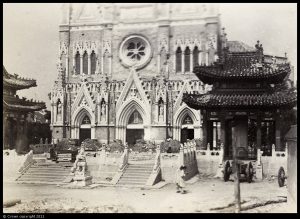
Beitang Cathedral – Approximately 1900
The Confucian Oppression of Christianity – Late 1700s-Early 1800s Jeonju, Korea: Because Christianity was not favored by the elites it gained popularity amongst the underprivileged. Also, the contrasting view of that all are equal under the eyes of God, to the Confucian view of hierarchy was appealing. This resulted in the formation of Catholic communities in Korea – people living together according to the ten commandments. Catholicism spread from Seoul all over Korea causing communities to appear all over the country. One of these communities, in Jeonju, was commented on by a French missionary in 1880. He speaks of their “trueness” to Christianity; how they have such virtue, love and care for one another despite their being in absolute poverty. They share what little they have in means of worldly possessions with no sense of status or implement of hierarchy. However, the spread of Christianity wasn’t without its consequences. From 1801 to 1802 156 individuals would lose their lives for treason, another 21 had already died for being Christians prior.

View of Present Day Jeonju South Korea
Protestant Christianity Arrives in the East – 1811 Canton, China: Like many religions before it, Protestant Christianity too came from China. In 1811 the first (as in first in Asia) Protestant text is published in China by Robert Morrison: a British missionary in Canton. At this time Christianity was still illegal in China so Christian literature was smuggled in on opium ships, which seems somewhat ironic. In the 1870’s Protestant Christianity begins to arrive in Korea and then the 1880s bring the arrival of American missionaries to Korea such as L. H. Underwood. The arrival of Americans in 1882, due to the treaty between Korea and America to “open” Korea, would also bring a huge influx of, technically illegal, Chinese Protestant books to Korea. Most of the Protestant literature that arrives in Korea at first is printed elsewhere and read by Koreans living elsewhere such as Mukden, Manchuria and Yokohama. However, while there was a sudden influx of texts, a majority of them were written in Chinese and none were written in Korean. Therefore, the Christian literature was only distributed to those of high social standing and high education. But the Protestants did something that would make one in every five South Koreans Protestant by the end of the 20th century. The Protestants made an effort to provide translated Korean texts, texts written in Hangul. This proved a difficult task in Translation due to the fact that the Korean intellectuals thought higher of Chinese adopted words than they did of those words of Korean origin. Therefore translators, in an effort to keep all of its audience, has to use words that were not too vulgar – words of Korean origin, and that weren’t too sophisticated – words of Chinese origin.
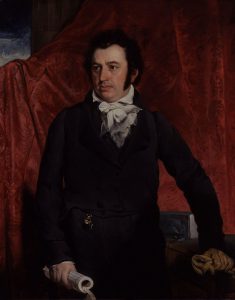
Robert Morrison

H. G. Underwood (left) L. H. Underwood (right)
A Scotsman Translates the First Korean Gospels – 1881 Mukden, China: The translation and publication of at least fifty Chinese Christian texts begins in Seoul 1881 and was completed by 1896. During this time, after the arrival of the American Methodist and Presbyterian missionaries in 1885, missionaries to Korea established the Korean Religious Tract Society and the Trilingual Press in 1889. These weren’t the only steps forward taken by Christianity during these years. In 1882 a Scottish missionary named John Ross, stationed in Mukden (present day Shenyang) China, printed the first Korean Gospels. He would then continue on to translate the whole New Testament in 1887. This original rough translation was full of lots of local dialectal forms of Korean due to the fact that Korean’s alphabet system, Hangeul, was not yet an established and agreed upon writing system. Not to mention the translation of Korean is difficult due to many other factors besides the unestablished writing system. Even in modern Korean word order is very different from that of English. Korean word order tends to be subject + object + verb and in the case of cause and effect, while cause is generally first, it doesn’t have to be. This can prove quite difficult when many passages in the bible have a specific word order to convey an aesthetic, but you also don’t want the translation to sound awkward to one’s reader. Another issue, especially in modern Korean, is the difference in spoken and written. Spoken style is very useful to connect with your audience, as Christianity is delivered in the form of a sermon, but can come across as somewhat casual for the use of scripture. Like when translators were choosing between words of Chinese origin or Korean origin, balance is absolutely crucial.
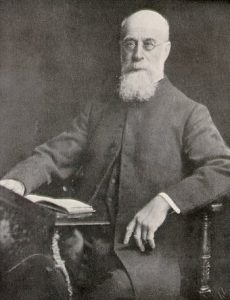
Missionary John Ross
Writing the New Testament in a Standardized Korean – 1903 Seoul, South Korea: In 1903 the Korean Church had its first New Testament and in 1910 revisions began for the revised 1937 version which is now the most used version in Korea today. Major changes to the Korean language were happening during this time. People like Chu Si-gyng were beginning to refine Hangul by publishing ‘Hangeul-only’ newspapers and Yu Kil-chun published Korean grammar books. Of course, the difficulty was the dialects as apparent in John Ross’s first attempt at translation of the New Testament. Yun Ch’i-ho pointed out that one of the difficulties of solidifying Korean was choosing what pronunciation of the different pronunciations was the ‘correct’ one. How do you choose a phonetic spelling when there is no set way to say something. Not to mention many biblical expressions are not easily translated into Korean, as such expressions simply do not exist. These translators would suffer from being bound by the original texts and thusly not being able to translate in such a way that was true to the text, but meaningful to the Korean speaker. Eventually the bible was acceptably translated and accessible to anyone, and because it was one of the first Korean texts written in Korean it was very often the first thing people had ever read. This spurred social change in Korea, not to mention the timely Japanese occupation in 1910. The Japanese occupation gave the Korean people a sense of relation to those they read about in the Bible. The Israelites enslaved to the Egyptians, the Jews suppressed by Roman rule. Therefore, had it not been for the Japanese occupation in conjunction with the rest of Christianity’s history in Korea, Christianity may not have reached its level of popularity today.
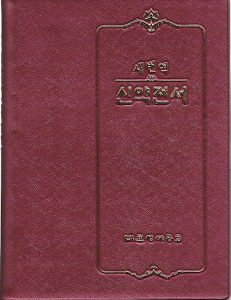
Korean New Testament
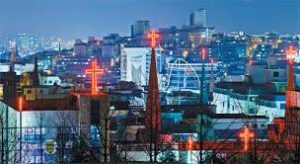
The View of Seoul at Night Looks a bit like a Graveyard due to the Church Lights
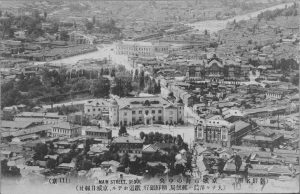
Seoul 1910

Modern Day Seoul